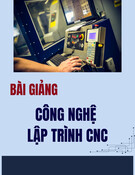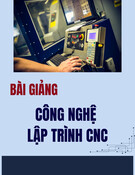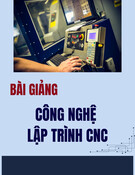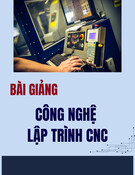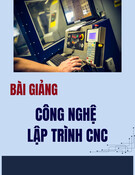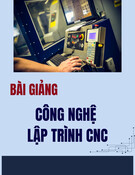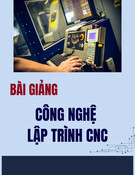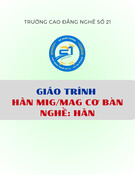
Journal of Science and Technique - Vol. 19, No. 03 (Nov. 2024)
72
STUDY OF AERODYNAMIC NOISE OF PROPELLER
CONSIDERING THE INFLUENCE OF BOUNDARY SURFACE
USING CFD METHOD
Thanh Dong Pham1,*, Quang Quyen Le1, Ngoc Thanh Dang1, Quoc Tru Vu1
1Faculty of Aerospace Engineering, Le Quy Don Technical University
Abstract
This article focuses on the aerodynamic and acoustic characteristics of both an isolated
propeller model and a propeller - boundary surface model. The study uses the Reynolds-
averaged Navier-Stokes (RANS) method combined with Computational Fluid Dynamics
techniques to analyze the flow field and wake flow behind the propeller and to determine its
basic aerodynamic coefficients. The pressure on the surface of the propeller and boundary
surface is used as input for the noise calculations. An acoustic analogy method, based on the
Farassat 1A formulation derived from the Ffowcs Williams-Hawkings (FW-H) equation, is
employed to calculate the propagation of noise from the surfaces of the propeller and
boundary surface to designated positions (microphones). The research results lead to some
significant conclusions drawn by the authors.
Keywords: Propeller; aerodynamic characteristics; acoustic characteristics; Farassat 1A.
1. Introduction
Awareness of the adverse effects of noise is increasing in modern society, leading
to more and more scientific research focusing on analyzing and seeking solutions to
reduce noise [1-3]. Propeller noise is a branch of aeroacoustics, related to the sound
generated by aerodynamic forces or unsteady turbulent motions of the airflow. On the
other hand, propellers are widely used in most Unmanned Aerial Systems (UAS) of
various sizes [4]. The efficiency of UAS operations, meeting mission requirements,
heavily depends on the aerodynamic and acoustic characteristics of the propellers during
takeoff and landing phases. This is because, when operating very close to the ground or
boundary surfaces, UAS create significant aerodynamic disturbances, often referred to as
"Ground Effect" [5, 6]. Operating within the Ground Effect can lead to changes in
aeroacoustics and increased noise levels, along with changes in stability and flight control
requirements. Therefore, studying the aerodynamic and aeroacoustic characteristics
during takeoff and landing, as well as the interaction of propellers with boundary surfaces,
is crucial. However, currently, there are not many published studies on the acoustic
* Corresponding author, email: pham.thanh-dong@lqdtu.edu.vn
DOI: 10.56651/lqdtu.jst.v19.n03.844

Tạp chí Khoa học và Kỹ thuật - ISSN 1859-0209
73
characteristics of propellers under these conditions. Furthermore, knowledge about
potential noise-reduction strategies for both propellers and boundary surfaces for
propeller design, runway surface design, and noise-reducing materials is still very limited.
Many methods for studying the aerodynamic noise of propellers have been developed
over the years [7]. However, the most comprehensive and commonly used in most
aeroacoustic research is the FW-H equation, published by Ffowcs Williams and Hawkings
in 1969, which clearly explains the formation and propagation of sound caused by any rigid
surface moving in space [7-10]. The outstanding advantage of the FW-H equation is its
various solutions, such as the Farassat 1 and 1A formulations [7, 8], and the 1C formulation
by Najafi-Yazdi [9], each of which can be used to solve many specific problems. Currently,
noise prediction and acoustic design of propellers mostly rely on the solution of the FW-H
equation [10]. In terms of approach, aside from a few studies that have independently
developed low-cost computational tools to predict the characteristics of propellers both
aerodynamically [11, 12] and aeroacoustically [13], numerical simulation methods and
experimental methods are widely used by many scientists today [14, 15]. In this article,
the authors aim to use the Computational Fluid Dynamics (CFD) simulation method on
Ansys Fluent software to study and determine the aerodynamic and acoustic characteristics
of a specific propeller considering the influence of the boundary surface. The research in
this article includes two processes: determining the aerodynamic characteristics of the
propeller under conditions affected by the boundary surface (ground effect) and calculating
sound radiation at desired receiving points by setting the surface pressure distribution of the
propeller and boundary surface as the sound source. This approach has been widely applied
and published in many studies in various fields [16-20].
2. Simulation model construction
2.1. Governing equations
Navier-Stokes equations: The flow field of the propeller can be assumed to be
quasi-steady. Therefore, based on the k-omega turbulence model, the RANS method can
be used to determine the average information of the flow field [16-18]. The Navier-Stokes
equation in a rotating coordinate system is used below:
V V V
dV F G dS dV
t
W W W n Q
(1)
where
n
is normal vector,
Q
is additional part causing by rotation,
, , , , T
u v w E
W=
, u, v, w are velocity components of fluid,
is density of the
fluid, E is internal energy of unit fluid,
FW
,
GW
are viscous flux and inviscid
flux, respectively.

Journal of Science and Technique - Vol. 19, No. 03 (Nov. 2024)
74
Ffowcs Williams-Hawkings Equation and Farassat 1 and 1A Formulas: In 1969,
Williams Ffowcs and Hawkings [10] used generalized function theory to derive the sound
equation of any rigid surface moving in a static fluid medium, known as the famous
FW-H equation. From the late 1970s to the early 1980s, Farassat published the renowned
Farassat 1 and Farassat 1A formulas [7, 8] based on the integral of the Green Function
and the transformation between spatial and time derivatives. These formulas are solutions
to the time-domain integral expressions for thickness noise (TN) and loading noise (LN)
of the FW-H equation. The Farassat 1A formula is expressed as below:
, , ,
TL
p x t p x t p x t
(2)
where
,p x t
is the total acoustic pressure at observers;
,
T
p x t
and
,
L
p x t
are the
pressure causing thickness noise and loading noise, respectively, and can be written as:
1
0
**
00
*
1
0*2
0
11
,4 1 4 1
1
41
j j j j
Tff
RR
ret ret
jj
fRret
Q n R Q n
p x t dS M dS
R M R M
R Q n
U dS
RM
(3)
*
* *2
00
11
,4 1 4 1
ij j i ij j i
Lff
RR
ret ret
L n R L n R
p x t dS dS
c R M R M
(4)
Here
;
R
tt
cc
xy
1
R i i
M v R
c
;
0 0 0
()
j j j j j j
Q u U v v U
;
0ij j j j j ij
L u u U v P
;
0ij ij ij
P p p
with
p
is the pressure at source points;
c
is the speed of sound;
0
is the airflow density; t is the time at observers;
is the retarded
time when the noise is emitted from the source to the observer;
Rxy
is the distance
between the observer and the source, x is the observer position vector, y is the source
position vector.
0f
is a function describing the blade surface (source surface);
From the acoustic pressure spectrum data obtained using formulas (2), (3), and (4),
the overall sound pressure level (OASPL) at a specific measurement location can be
determined. OASPL is a single numerical value that describes the noise source and is
defined as the average of all individual sound pressure levels at the frequencies emitted
by the noise source. OASPL can be determined using the following expression:

Tạp chí Khoa học và Kỹ thuật - ISSN 1859-0209
75
12
SPL SPL
SPL SPL
10 10 10 10
10 10
1
10 log 10 logOASPL 10 10 10 ... 10
in
n
i
(5)
where SPL1, SPL2,…, SPLn are sound pressure levels at different frequencies, dB.
2.2. Numerical simulation
The 3D propeller model was constructed using the Inventor graphics software with
the geometric dimensions shown in Tab. 1 and Fig. 1. The 3D propeller model consists
of 2 blades, as illustrated in Fig. 2.
Tab. 1. Geometrical data of propeller
Parameters
Measurements
Diameter D (mm)
150
Chord width (mm)
11
Pitch angle (°)
35
Number of blades n
2
Angular speed Ω (rpm)
5000, 6000, 7000
Fig. 1. Geometrical parameters of propeller blade.
The boundary surface is simulated as a thin plate with dimensions of 10R × 10R
(where R is the radius of the propeller blade), positioned below the rotor at a distance h.
In this simulation model, the distance h is set to values of 0.5R, 1.0R, and 1.5R (Fig. 2).
To measure acoustic data, the authors placed microphones at coordinates mic 1 (1.12,
1.34, 0), mic 2 (1.75, 0, 0), and mic 3 (0.877, -1.5, 0). The microphones are positioned on
a circle with a radius of 14R from the propeller center, forming angles of 40°, 90°, and
150° with the vertical axis (Fig. 3). Regarding flight mode, this paper focuses on studying
the aerodynamic and acoustic characteristics of the propeller in hover mode, which is
the basic operational mode during takeoff and landing for small helicopters and rotor-
based UAVs.
Using the RANS method combined with CFD techniques integrated within the Ansys
Fluent software, the authors proceeded to mesh the survey model, select the viscosity
model, set boundary conditions, etc., following steps similar to those in the study [21].
The size of the computational domain (static domain) for the aeroacoustic model
Propeller - Boundary surface (Pro - BF) is shown in Fig. 3.
0
5
10
15
20
25
30
35
40
0 0.2 0.4 0.6 0.8 1
Pitch Angle, 0C
Chord, mm
r/R
Pitch angle
Chord

Journal of Science and Technique - Vol. 19, No. 03 (Nov. 2024)
76
a)
b)
Fig. 2. 3D model of propeller (a) and boundary surface (b).
The mesh density was concentrated around the propeller blade and the rotating
region, with the boundary layer mesh around the propeller blade consisting of 5 layers
with a growth rate of 1.2 (Fig. 4).
Fig. 3. Microphone positions for measuring
aerodynamic noise characteristics.
Fig. 4. Grid of domains and propeller.
Simulations were conducted for the propeller model in hovering mode based on the
RANS equations with the k-omega SST turbulence model, at an angular velocity of
5000 rpm. Boundary conditions were set for unsteady, compressible flow following the
ideal gas law. The boundary condition for the inlet flow was set as Pressure_inlet, and for
the outlet flow as Pressure_outlet with values equal to ambient pressure; the wall flow
had a velocity of 0. To study the sensitivity of the mesh to the calculation results, the
authors determined the thrust coefficient and the torque coefficient of the independent
rotor in the case of hovering flight, the rotation speed is 5000 rpm with 3 different mesh
sizes of 863000, 1031441 and 1561441 elements, respectively. The calculation data are
shown in Tab. 2. The data show that 1031441 grid cells are sufficient to meet the


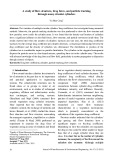
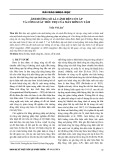

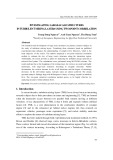


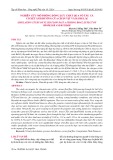

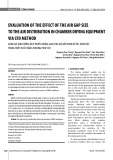
![Bài tập tối ưu trong gia công cắt gọt [kèm lời giải chi tiết]](https://cdn.tailieu.vn/images/document/thumbnail/2025/20251129/dinhd8055/135x160/26351764558606.jpg)




